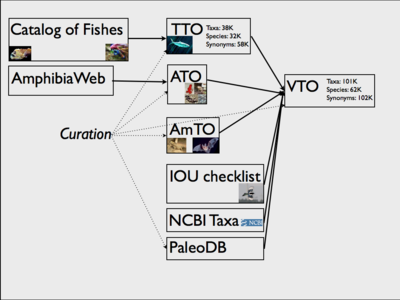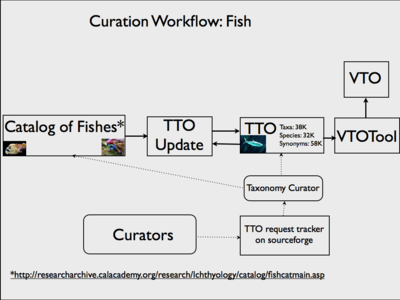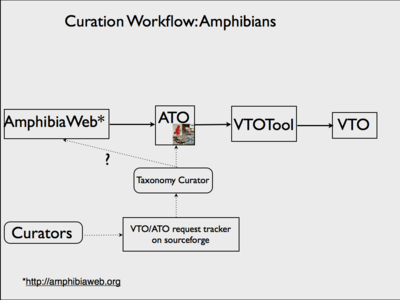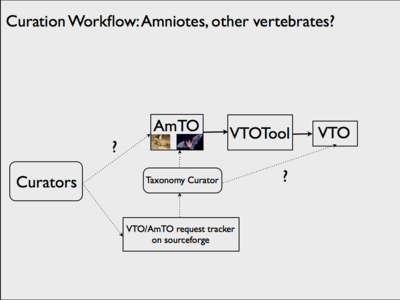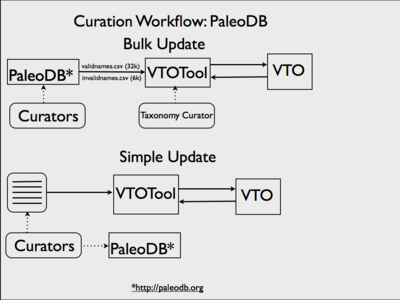Anatomy Ontology Conf calls
Weekly anatomy ontology calls are held on Mondays, 1:15 pm - 2:15 pm ET.
Contents
- 1 Feb 6, 2012
- 2 Jan 23, 2012
- 3 Nov 29, 2011
- 4 Nov 21, 2011 -- Taxonomy Ontology call
- 5 Nov 7, 2011
- 6 Oct 17, 2011
- 7 Oct 17, 2011
- 8 Oct 10, 2011
- 9 Sep 26, 2011
- 10 Sep 12, 2011
- 11 Sep 12, 2011
- 12 Sep 5, 2011 No call (Labor Day)
- 13 Aug 29, 2011
- 14 Aug 15, 2011
- 15 Aug 8, 2011
- 16 July 27, 2011
- 17 July 18, 2011
- 18 July 11, 2011
- 19 June 13, 2011
Feb 6, 2012
Review and discussion of proposed definitions, labels, and synonyms for limb podium terms
Jan 23, 2012
Agenda
Nizar will give an update on the limb terms and definitions - see Google docs AMAO-Appendicular and VAO-appendicular.
Attending: Nizar, Dave, Christina, VG, Erik, Terry, Paula, Wasila
Minutes
Nizar, discussion of AMAO and VAO terms:
- Currently working on specific terms and higher level terms from AMAO, VAO, and CARO
- Also going to highest levels (e.g., anatomical entity) for review
- Created new OBO file that they can edit all three ontologies directly
- Will generate diff file (using GO diff tool) to keep track of proposed changes to VAO and CARO. Changes to AMAO will be preserved.
- Provenance: Nizar has been doing index search for original definitions;
- Podium terms in original literature, defined by Haeckel in 1895. Refers to skeletal elements only
- would prefer to reserve podium terms for skeletal only
- Terry: need to have a way to designate the limb segments as well that contain skeletal elements
- Could have two terms: stylopodial segment of limb and stylopod skeleton
- could also have stylopod as related synonym for two terms 'stylopodium skeleton' and 'stylopodial limb segment'
- David: usability very important, at least include recent usage as a pointer to historical usage
- Terry: better to define regional limb terms by the skeletal elements contained within, because terms like "arm" are confused in the literature
- Nizar: similar problem with terms like cranial skeleton, axial skeleton, postcranial axial skeleton; his community wouldn't include cranial as part of axial skeleton
- may need to be defined differently across ontologies; or treat as a presentation issue: not necessarily that cranium doesn't have axial parts in it
- In defining limb terms encounter difficulty in defining terms by internal elements; when lose structures becomes difficult
AMAO terms and curation
- Nizar will write AMAO defs at level of archosaurs
- Paula: yes, and have terms done for curation of archosaur limb literature first
- will result in "uneven" ontology but need to focus effort with eye on curation
Nov 29, 2011
Agenda
Melissa will lead the call summarizing proposed updates and requests to process terms related to the skeletal system in the Gene Ontology, extending the work done at last year's skeletal anatomy workshop. These terms will be integrated in VAO cross-product definitions.
Attending: Ceri, Yvonne, Terry, Melissa, Nizar, David
Minutes
- Gene ontology - 5 new classes being proposed (see slides)
- develops_from vs. replaced_by relation: cartilage doesn’t develop into a bone element; it’s “replaced by” bone and incoming osteoblasts
- Endochondral ossification definition: doesn’t need to be mineralized to replace bone, so removed that clause
- perichondral definition – some ossification occurs off the periosteum but not adjacent to it, so worded as from the surface rather than adjacent to
- intratendonous ossification results in formation of ossified tendon [TO DO:change primary label on VAO term from ‘intratendonous ossification’ to ‘ossified tendon’
- Relation for GO processes: “results_in_formation_of” or “participates_in”/”has_participants_in” [input/output has participants in it] so might not want to use participates_in -- need to define subproperties
- Ligamentous ossification: replacement ossification – there is a ligament model replaced by a bone model; could also say that within a ligament have metaplastic ossification – ligament cell becomes bone without dividing; probably have both going on in one skeletal element
- Terms for modeling vs. remodeling vs. maturation have community specific definitions:
- clinical: bone modeling (maintenance), bone remodeling (injury) which might be normal response to injury and not pathological; bone maturation
- David: comparative literature, especially for amphibs, refers to bone remodeling for change in morphology in ontogeny
Nov 21, 2011 -- Taxonomy Ontology call
Agenda
- Discuss VTO workflow and curation of taxonomic names
Attending: Peter, Wasila, Paula, Ben, Nizar, Hilmar
Minutes
- VTO Tool takes taxonomies and puts them together
- Planning to use single tracker (VTO tracker - link]
- Review of workflow for taxonomic groups (see slides)
- Pending AMTO from Paul, could use NCBI scaffolding to curate directly in VTO
- PBDB
- "bulk" update grabs all chordate data; needs review by curator; would have list of species with invalid parents
- Action item: Peter to post list of problematic taxa, which can be fixed if corrected by curators
- "simple" update - curator provides list of names for VTO; only update is to names curator provides
- PBDB is patchy, not a complete taxonomy; VTO update from PBDB gives new terms and path to root, but doesn't change what's already in VTO
- Plans
- Nizar can create a basic amniote taxonomy based on standard references, put in excel for Peter to pull into VTO
Slides
|
| |
|
|
|
Nov 7, 2011
Agenda
- Addition of fin terms (available from TAO) to VAO for annotation of basal vertebrate phenotypes (add to tracker)
- Review of proposed updates to cranial skeleton terms (from recent work with John Lundberg)
Attending: Ceri, Terry, Yvonne, Melissa, Paula, Ben, Wasila, David
Minutes
- Addition of fin terms (available from TAO) to VAO for annotation of basal vertebrate phenotypes
- Melissa: terms outside musculoskeletal scope (e.g., dorsal fin) are available in UBERON. These are organism subdivisions rather than skeletal subdivisions
- organism subdivisions- large portions with various organs/ elements included as part of “chunk” or organismsum of parts don’t add up to what is seen on surface, not adquately represented in CARO yet
- VAO scope is musculoskeletal, import ‘dorsal fin’ from Uberon and have “dorsal fin skeleton” be part_of
- Don’t need to import all of Uberon, import single classes or specific vertebrate files, not all of it.
- Can also use placeholder term in Vao which gets obsoleted and replaced with term imported from existing ontologies
- Melissa: Ideally would import from Uberon but tools not there yet
- Paula: Median fins don’t develop from fin buds, we have the develop_from relationship in TAO/ZFA, how to change relationship for VAO? change in all ontologies—add to tracker in Uberon—developing tools to see differences and populate ontologies from higher ontologies
- Melissa: terms outside musculoskeletal scope (e.g., dorsal fin) are available in UBERON. These are organism subdivisions rather than skeletal subdivisions
- Review of proposed updates to cranial skeleton terms spreadsheet
- Chondrocranium could be defined logically as restricted set of replacement elements that is not replaced by mineralized tissue
- Paul: chondrocranium and neurocranium used interchangeably- a problem, disparity in different types of literature over time
- Paul generally agrees with using chondrocranium for the splanchnocranium + neurocranium precursors as there is no term for the full chondrocranium
- Action item: everyone fill in relevant cells in cranial skeleton spreadsheet for their ontology
- Action item: Nizar and Paul to review limb and cranial skeleton spreadsheets
Oct 17, 2011
Agenda
- Review "Podium terms" GoogleDoc spreadsheet
- Pectoral and pelvic fin representation - see CARO tracker item
Attending: Ceri, Terry, Monte, Yvonne, Christina, VG, Melissa, Chris, Ben, Wasila
Minutes
- Proposed synonyms of podial terms (e.g., upper arm, crus etc…) see spreadsheet
- Arm and leg defined differently:
- In MA, VAO, arm = forelimb stylopod + forelimb zeugopod
- In FMA, arm = forelimb stylopod
- In MA, leg = hindlimb stylopod + hindlimb zeugopod ; (leg not in VAO)
- In FMA, leg = hindlimb zeugopodium
- Question: wrist/ankle = synonyms of forelimb mesopodium/hindlimb mesopodium?
- Terry: no, Common usage of wrist includes joint- composed of multiple articulations, zeugopodial segments, specific tendons, ligaments, etc...
- Wrist region might be better term to represent everything; parent is_a anatomical cluster
- CARO appendage: refer to pelvic and pectoral regions? Or just sticking out part?
- Terry to look into development of appendages and girdles
Minutes
Oct 17, 2011
Agenda
- "podium" terms (stylodpod, zeugopod, autopod) as limb segments/ organism subdivisions vs. skeletal subdivisions
- documentation of discussions, references, and resources in ontology development
Attending: Wasila, Ceri, Yvonne, Monte, Terry, David, Paula, Chris, Christina, VG, Paul, Ben
Minutes
_Podium terms
- In Uberon, FMA, and MA, podium terms are types of limb segments; in AAO, they are types of skeletal subdivisions
- Literature is also mixed (examples presented); Might be consequence of skeletal elements being the most discrete embryologically, but assume patterning of soft tissues is also present. Paul: most of his literature refers to skeletal only.
- Could keep stylopod and introduce "skeleton of stylopod" terms
- Or 'stylopod skeletal element' term (part_of stylopod)
- Everyone to review Google doc spreadsheet "podium terms" for discussion next week
- Chris: terms for shoulders, wrists, joints vary in relationships to regions
- adjacent_to vs. overlaps; overlaps seems more appropriate:
- knee region overlaps stylopod + zeugopod
- humerus is contained in the shoulder region, but not the entire humerus, so use overlaps relation
- Chris: FMA uniquely among AOs has girdle part_of limb; FMA:free limb equivalent to "limb" in other AOs
- Terry: limb field developmentally gives rise to girdle (possibly)
- Appendage is term that includes girdle with limb (=pectoral appendage or pelvic appendage for VAO)
Term documentation
- Chris: GO refs
- links from term to references and other links within GO Ref
- ZFA has ZFIN virtual publication
- Paula: will ask Todd about microattribution
Oct 10, 2011
Agenda
Attending:
Minutes
Sep 26, 2011
Agenda
- Full vs. partial synchronization of model organism and multi-species ontologies
Attending: Jim, Wasila, Yvonne, Monte, Paula, Chris, Terry, Christina, VG
Minutes
- Wasila: Currently, TAO duplicates all ZFA terms, meaning that every term in ZFA has a corresponding term in TAO; links to gene data.
- ZFA duplicates only zebrafish-applicable terms and only terms that might be needed for curation (e.g., some skeletal element terms, although applicable to zfish, not added to ZFA).
- Chris pointed out that a reasoner can do the integration between TAO and ZFA. Would lessen the work involved in synchronizing and wouldn't need to duplicate every ZFA term in TAO
- Reasoning: can bridging axioms handle this? Jim: bridging axioms can be generated from xrefs
- Jim: in the redesigned version of the KB, this will work
- How to keep track of terms that don’t apply to zfish or tao? Don’t want to re-visit each time…. Need to have a diff file for each release…
- Chris: Do you want branch-specific exclusion?
- Probably not needed; not a big task to review newly added terms for inclusion/exclusion
- doing subsets with the synch tool;
- exclude from zfa (housed in tao)
- exclude from tao (housed in zfa)
- Subset tag (=slim) – a tao subset that excludes the terms from zfa
- for each term in the ontology, check box in OBO Edit – would add subset line to ZFA has "exclude from TAO" subset; TAO has "exclude from ZFA" subset
- discussed creating separate subsets for different reasons for exclusion; decided it was better to begin simple with one subset
- Paula: Is there a way to make a comment appear after subset in OBO format?
- Chris: trailing qualifier can be used in OBO format - line or two of free txt, in {}; not sure if preserved in OBO-edit
- Could also use a shared external file containing subset info, readable by Synch Tool
- Jim’s time: 1-2 days of coding…. (working just on this…)
Sep 12, 2011
Agenda
Sep 12, 2011
Agenda
Semantics of phenotype annotations (Jim)
- Jim to describe query results on KB interface for ancestral state annotation
Sep 5, 2011 No call (Labor Day)
Aug 29, 2011
Attending: Monte, Terry, Chris, Wasila, Jim, Paula, Yvonne, VG, Christina, Hilmar (first half)
Agenda
- annotation tools for Phenoscape: requirements and the pros and cons of desktop vs. web-based annotation tools (Wasila)
- instance-based annotation model (Jim)
- full vs. partial synchronization (for next week?)
Minutes
Jim led discussion on Semantics of phenotype annotations
Aug 15, 2011
Attending: Chris, Paula, Wasila, Jim, Erik, Terry, Paul
Agenda
- Chris will present on ontology modularization - Download slides from ICBO 2011
- Discuss need for complete vs. partial synchronization
Minutes
Aug 8, 2011
Attending: Terry, Chris, Wasila, Jim, Paula, Yvonne
Agenda
Review Obo-Edit Synchronization Tool
Minutes
For obsoleted terms, give reason for obsoletion in comments field
Synch tool review
- Features and bug reports (already on request tracker)
- indicate (by color) and filter obsolete terms
- Conflicting data tab: synonyms not copied over
- Missing terms: filter TAO terms with never_in_taxon links to D. rerio
- Some conflicting data will be ok. For example, a ZFA definition may begin with the broad genus-differentia definition shared with the corresponding TAO term, followed by zfish specific information not in TAO definition.
- To maintain needed differences between ontologies (e.g., differences between defs, relationships, synonyms), synch tool could interact with a local file that keeps track of differences so that curator doesn't need to review these in each synch session
Long-term synch goals
- Chris - use annotations to guide ontology synch. For example, vertebra 1 part_of Weberian apparatus in Danio rerio allows this relationship in ZFA and explains its absence in TAO.
- Could also make use of textual annotations for synchronization
Working plan: update synch tool with easy fixes and requests, and reassess its use after one year
Complete or partial synchronization? Chris: instantiating everything in TAO is probably not necessary (e.g., every term added to ZFA currently gets duplicated in TAO). In some cases, ZFA would have very specific terms defined based on zfish research but unknown in other teleosts. Should still be able to search genes on these terms because their parents are cross-referenced.
July 27, 2011
ICBO Anatomy Workshop Notes
- ZFA in charge of mapping to Cl
- TAO responsible for transitively linking to ZFA/Cl
- When MIREOTing should be recording version of ontology you are using (is this captured in release notes?); do filtered save, allow dangling refs.
- David importing is_a tree to root, assuming tree is reasoned
- Communication important, but also having clear lines of responsibility important
- If ZFA has two parallel classes infer the Cl; ask what asserted is_a links in Cl are not the correct inference for ZFA; which is_a links do I not re-infer in ZFA; down the line cache on a per term basis
- VAO only skeletal, UBERON will hold everything else (common/universal/non-species specific terms)
- ZFA needs to be doing intersections now. Strip them out for the database - they don't really need them do they?
- Treat Phenoscape like a special case of ZFA/ZFIN to understand how to do the hard queries that utilize the intersections
- TAO wants to import CARO and VAO; do filtered save as TAO; How do you add new imported terms?(David copy and pastes in, stripping out all relations?); Ideally plugin or webservice for OBOedit
July 18, 2011
Attending: Terry, Christina, VG, Paula, Chris, Dave, Erik, Wasila
Agenda
Discuss strategies for cross-species ontology synchronization
- multispecies ontologies and import vs. MIREOT
- tool support for import/mireot in Obo-Edit
- species specific ontologies and macro x-refs
- XAO/AAO plan
- tool support for synchronization (Obo-edit; GO diff tool)
Minutes
Multispecies ontologies and import vs. MIREOT
- MIREOT lets you import a part of an ontology (e.g. so that we don’t get ‘tibia’ in the teleost ontology)
- Mireot only developed in owl; applied mainly in cell ontology to date; easier than working with imports because can extract a submodule as basis for the import; variation of it in obo-edit where you save only the relevant terms (save is_a closure)
- develop a subset file - need external script to keep subset synchronized
- WD: Plans to develop a mireot module for obo? Roundtripping tool being developed for OWL
- another option: use ‘never in taxon’ designation instead of mireot; Put taxon info in VAO with never_in_taxon links; TAO/VAO e.g. –want to import only teleost specific;
- never_in_taxon will be difficult for e.g., structures lost repeatedly in a clade
- Homology discussion
- Don't add terms to VAO that are not required [incomplete notes here...]
- For now: just import/mireot the whole thing
- Better tool support needed
Species specific ontologies and macro x-refs
- XAO/AAO plan originally involved merging AAO into XAO, with AAO terms being alt-ids ot XAO terms. But messy to deal with alt-ids and obsoleting terms in XAO
- New plan for AAO/XAO alignment using xrefs
- At end of year 1 would clone out AAO (keeping original AAO ids) terms not in Xenopus added back to AAO
- OK to add VAO xrefs (with David) to AAO now and then
- XAO would preferentially xref VAO terms where they are available
- Primary location of xrefs would be in XAO now; the ssAOs hold xrefs to multispecies
- Another issue: where XAO to get non-skel terms; not ideal to xref ZFA
- Uberon xrefs AAO; easier to do from purpose of synchronization
- currently XAO xrefs ZFA - should they be maintained? Keep as historical record and leave as xrefs without defined semantics; don't rush to get rid of
WD: should AAO hold xrefs to Uberon or Uberon to AAO? CM: doesn't matter which file it lives in - need a bridging file which contains axioms for xrefs
- XAO workflow: if XAO need a new term, where to get them? Better to get term from higher level
- in order of preference for a new term: AAO, VAO, Uberon, ZFA, create new term (no xref needed)
- if AAO xrefs VAO, then VAO ID should be used preferentially over AAO id
- non-skel terms not added to AAO until cloning
- Should terms be directlly requested from Uberon? Could do that or on the other hand, UBeron will pick up new terms when it gets updated
- When pulling terms from above and definition is terrible, then start an external dialogue to fix it.
July 11, 2011
Attending: Judy, Terry, Monte, Aaron, Christina, VG, Wasila
Agenda
1. Review anatomy ontology development plans
2. Alternative formalisms for inter-ontology links. From Chris email, 7/8/2011:
- equivalence (e.g. VAO:ligament equivalentTo Uberon:skeletal_ligament)
- subclass_of (e.g. EMAPA:islets_of_langerhans SubClassOf Uberon:islets_of_langerhans) note that EMAPA includes several classes called "islet of langerhans" and no single generic class, so we're forced to use subclass here
- equivalence given a taxon (e.g. MA:ligament EquivalentTo Uberon:ligament and partOf some NCBITaxon:10090)
3. Discuss use of vertebrate anatomy term tracker and mailing lists
4. Issues raised by Chris:
- alternate project meetings with calls where we invite other members of the obo-anatomy list?
- make the agenda pages on the wiki publicly readable?
Minutes
1. Reviewed ontology development plan for year 1:
- multispecies ontologies (TAO, AAO, AMAO) will import VAO; cross references in VAO, TAO, AAO, AMAO to upperlevel ontologies unnecessary
- Action item: Chris and Jim to discuss handling of imports in OWL version of ontologies
- single species ontologies (MA, XAO, ZFA) will maintain species-specific versions of terms, and cross reference VAO and appropriate multispecies ontology
- Cross references in single species ontologies are specified as "equivalent in taxon" links by having a line describing the meaning of the xref in the header of ontology file; for example, ZFA has the following lines in the header:
treat-xrefs-as-genus-differentia: CL part_of NCBITaxon:7955 treat-xrefs-as-genus-differentia: TAO part_of NCBITaxon:7955 treat-xrefs-as-genus-differentia: CARO part_of NCBITaxon:7955
- macro-xrefs tralsated into owl: ZFA term is the equivalent of the TAO term
- Beware if two terms xref a single term: indicates that there is a duplicate term (error)
Aaron: XAO will be adding upwards of several thousand terms, many embryological; will ref ZFA, VAO, CARO
- will be done manually, case by case basis, - are there tools for automating this?
- Action item: Chris and Jim to discuss tools for adding large chunks of ontologies to other ontologies - Paula suggests involving Jeff Bowes
- Chris: mapping issue here: don't xref at sibling level (e.g., XAO shouldn't xref ZFA), should inherit the term
- Long term goal for XAO is to follow import model;
Chris: need generic guidelines for when to subtype and when to merge
- when need to designate develops_from relationship that is not general, would create a subclass rather than add relationship at amphibian level
- this is a shortterm solution; get latticy ontology, difficult to navigate
Wasila: way to handle taxonomically variable relationships as annotations? Chris: difficult to edit a separate data table, which would need extensions and way to view as ontology relationships
Terry: possible redundancy issue: Uberon has skeletal terms that VAO doesn't yet; what should be xrefed?
Wasila: VAO is musculo-skeletal so xrefs should be made to VAO; non-skeletal terms can be xrefed to Uberon
- Term addition to VAO is ongoing, but focus xref addition on limb/fin anatomy in first year
Decided to keep this time slot for project specific issues but there is interest in participating in a general call; also could revisit using this time slot after project work settles down
June 13, 2011
Attending: Monte Westerfield, Paula Mabee, Judy Blake, Aaron Zorn, Jeff Bowes, Wasila Dahdul, Jim Balhoff, Terry Hayamizu
Agenda
- Judy:
- Discussion on how to initiate the Amniote Anatomy Ontology for terms outside skeletal system
- Report on status of unified anatomy [emap + MA]
- What exactly is abstract mouse?
- Clone MA, UBERON, unified mouse [emap + MA], or abstract mouse?
- Monte:
- Discussion on moving ZFA to GO like model; possibility of implementing VAO import (so that XAO can just clone this VAO chunk when they also clone the rest of ZFA)
- Aaron and Jeff:
- Discussion on setting up modular ontology model and specifics of importing model species-specific information (like devo stage)
Action items resulting from call:
- Monte: Charge to the zfin group (from Monte) is to write up plan and potential problems
- Judy: Will send Jim contact for Amelia Ireland for diff
- All: short term goal to add xrefs to VAO to ZFA, XAO, MA
- Wasila: give VAO write access to other groups
- Wasila: find out how often UBERON gets updated -- done WD 6/25/2011
- Wasila: Schedule weekly meeting to sort out what is happening in these AOs, beginning in July -- done WD 6/25/2011
Minutes
- Wasila will demonstrate diffs between Uberon and MA using non-skeletal terms
- e.g. 'naris' in mouse is 'part of nose'
- e.g. 'naris' in uberon with lots of xrefs but missing relationship 'part of' olfactory apparatus
- not sure how often Chris updates Uberon
- Terry - developed adult Mouse Anatomy; working with Edinburgh group to update their ontology
- 'unified mouse anatomy' not an official term, just a descriptor
- Ed. developmental mouse anatomy developed 15 years ago in an effort to code mouse expressiondata. Built along lines of an atlas by kauffman and baird; partonomy; Used for expression annotation by ... for years now. Two parts: abstract mouse which is a time -inedpent collection of terms in a hierarhy not a dag; and from that extracted stage-dependent hierarchies. stage 28 is postnatal -- this is not developed at all. 8-10 years ago, a postnatal developed by jax. jax added is-a and expanded on stages. Examined all relevant ontologies in updating. Two entities (MA vs. developmental) not connected currently -- working to make it an anatomy ontology encompassing the whole of mouse development.
- Q: re: timeline? Terry: within next two weeks could give clearer answer.
- would like to work with rest of ao community to make it a resource that will best serve needs of community. It works for expression and for phenotype, but needs to work better for other communities. Have updated based on other working groups. Would like to work to update weak points.
- Judy - Terry funded for small portion of time on issues relevant to project
- Wasila - use mouse
- Judy -- start with MA, great place to start. Talk with Chris to see where he last updated and worked with it.
- Terry -- Uberon - made an effort to take into consideration only things that are shared - not less valuable for it; structurally less consistent than mouse; mouse is lacking becuase of roots in ed anatomy and purpose for expression -- so the high level structure is a partonomy; first level division into regions, then into organ systems, etc. Need to think about primary goals of new ontology. Where along tree does it no longer serve amniotes or chickens?
- Some avian terms are already in uberon -- use mixed approach. Also uberon follows more of a is_a approach;
- MA, Uberon, VAO, AmAO are all separate right now; good documentation of proposed changes;
- Judy: suggestion -- all work together on one aspect at a time - start with limb/fin
- Terry: Historically for MA, when significant changes made, to a section in response to some input; not a constant stream of changes; structurally and in terms of big picture, not changes often. Need to do in coordination.
- Wasila: Conclude -- need mixed approach
- Monte:
- Need to improve ways of synchronizing zfish ontology with vao, uberon, etc. Met with db admins etc. to discuss future re: ontologies and new mechanism to stay in synch. Potential problem is that lead curator out on maternity leave, so people he discussed it with not necessarily in charge, but they understood basic issue. Charge to the zfin group (from Monte) is to write up plan and potential problems. Briefly -- problem how to grow two ontologies grow in synch. Big concern that curators have is if they become dependent on outside group such as Phenoscape, there could be changes made without consideration for the implications of zfin. Also, term request brokerage rights need to be grant to zfin. Need to work out sop for how updates are made.
- Concern how we represent developmental staging. Start and stop times in same db table. If bringing in terms from outside resource, will break the devo and it will have to be moved to an outside table. This has implications for xao. If xao is dependent on zfin, this will take some time.
- Aaron: best way to go is to clone zfa. Have to develop ways to import VAO.
- Jeff: Inheritance structure?
- Wasila: Yes, direct links
- Jeff: inheritance from next highest ontology? correct?
- Wasila: Yes, go up to next higher level ontology.
- Jeff: Given current architecture, not hard to do. However concerns about changing higher level terms and effects on lower level terms.
- Monte: talked about how zfin does with go currently - via diffs list - not overly onerous - but have to have sop - can run checks on reasoning, but human will have to fix a couple of things
- Judy - -yes
- Aaron: VAO not complete for all organ systems....how does this work?
- Jeff: This is ok -- for terms that exist in VAO, we can show as inherited.
- Jeff: Development not taken into account in higher-level ontologies. Have to have a way to associate development with terms. Just show which terms are inherited and maintain just as we do now.
- Aaron: Will clone vao and zfa terms and keep xrefs. When we transition to other system, can track what we are importing.
- In short term, clone vao terms into xao - ok?
- Short term goal: Add xrefs to VAO to ZFA, XAO, MA
- Judy: weekly meeting to sort out what is happening in these anatomies?
- Wasila: yes, it would be useful
- Aaron: jamboree approach --
- Judy: Even a 1/2 hour check up
- Wasila: Even a open weekly call
- Judy: open up wiki for agenda building and notes
- Aaron re: data jam: 22 Aug-26 Aug; Erik S for 5 days
- Paula: Most efficient way to add xrefs to VAO to zfa etc.?
- Monte: ZFA and XAO etc. need write access to VAO
- Paula: Jim -- how to get this diff file automatically generated?
- Judy: Will send Jim contact for Amelia Ireland for diff
- Wasila: Will give write access to VAO to other groups. Will be making lots of changes over next two months.
- Paula: How coordinated in GO?
- Judy: Webex every/most mornings by the GO development team, share screen and work together ---additions at leaves easy; others assigned to people; coordination - big branches worked on by whole group
- bowes@ucalgary.ca and terry to be added to email list; Wasila will send out notes
